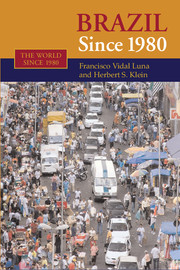Book contents
Introduction
Published online by Cambridge University Press: 03 June 2010
Summary
Brazil today is the fifth largest nation in the world in terms of population and the size of its territory. It has the most advanced industrial base in Latin America and has become one of the world's most important agricultural producers. Much of what Brazil is today is the result of major transformations that have occurred only in the past quarter century. In 1980, it ranked poorly even among most Latin American countries in terms of the health and education of its population, it contained one of the region's poorest and most backward rural sectors, and it maintained a large but closed economy. Its primary exports were unprocessed raw materials, its industries, although quite important, produced only for the national market, and its political institutions were extremely fragile after passing through one of the longest periods of military rule in Latin American history.
In the past quarter century, Brazil has undergone profound social, economic, and political changes. For the first time in its Republican history, it has established a vibrant and functioning democratic system, free from military tutelage and the populist politicians who had created such profound instability in the previous century of republican rule. It was in this period that Brazil fortified its position in the world economy by becoming one of the largest international exporters of numerous agricultural products on the level of Canada, the United States, and Australia.
- Type
- Chapter
- Information
- Brazil since 1980 , pp. 1 - 5Publisher: Cambridge University PressPrint publication year: 2006



